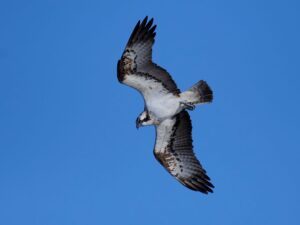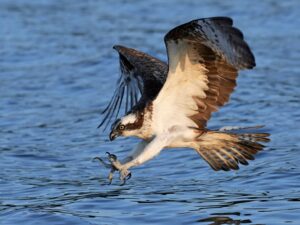Return of the Osprey – Welcome Home!
 The Osprey was driven to extinction likely prior to 1800 on this island, with some of the last records of over-summering Osprey from 1880s around Lower Lough Neagh. Ospreys feed almost exclusively on fish, including fresh-water, estuarine or open salt-water.
The Osprey was driven to extinction likely prior to 1800 on this island, with some of the last records of over-summering Osprey from 1880s around Lower Lough Neagh. Ospreys feed almost exclusively on fish, including fresh-water, estuarine or open salt-water.
In historical times the birds were often considered a threat to trout and salmon stocks; they were hunted for sport and taxidermy; and their eggs were sought by collectors. Habitat loss, the destruction of nest sites and industrial pollution of water sources also contributed to their decline across the range. This loss of such an iconic species, sometimes known as the “fish hawk”, is a symbol of absent heritage of our wetlands and waterways.
The frequency of Osprey observed at important staging sites on migration in Ireland has significantly increased in the last 20 years in line with the expansion and recovery of the Scottish breeding Osprey population. NIRSG volunteers and raptor fieldworkers have recorded an increase in birds seen during the summer, particularly around Lough Neagh, Fermanagh Lakelands and along the north and east coast.
There was an adult seen carrying fish during the breeding season, indicative of a potentially active nest somewhere and even two recently fledged young were seen together in 2019. They remained elusive and somewhat of an enigma, but the pieces of the jigsaw were building slowly and finally, almost 70 years since the first Ospreys returned to Britain, to Loch Garten near Inverness in 1954, there is a confirmed nest location and successful breeding recorded in Northern Ireland.
Much preparatory work has gone on by Golden Eagle Trust, NIRSG and the IRSG, to prepare for the return of the Osprey over recent decades across Ireland, north and south. Osprey monitoring, of both migrating and over-summering birds, the erection of platforms and too the planning for translocation and reintroduction efforts have been taking place across the Island for several decades and these efforts have now been boosted by Fermanagh’s naturally established birds.
It was considered that a re-introduction programme may be the only way to kick-start the population here – given that the birds are so site faithful and males in particular return to nest close to where they were born. But this pair of breeding adults will now attract other young birds here and slowly but surely, we hope a core population will build and thrive – the most western location for the species in Europe.

Work alongside local communities, building awareness and understanding of the species in the wider landscape and to protect the birds and their nests will continue to be important over coming years to support this Osprey breeding nucleus in the north-west.
So look out for these incredible birds from mid-March to August, plunging into waterbodies and, sodden and bedraggled, they take flight, wrestling with a large fish. Ospreys are brown on top and pale underneath, with black patches near the carpal, or wrist. They have a wingspan of 1.5m, one of our largest birds of prey, but they can be mistaken for a large gull at distance – though the protruding head with thick dark eye stripes with a white crown gives them away.
Keep your eyes to the skies next spring and keeps fingers crossed that young birds passing by on homeward migration take a second look at Northern Ireland and come join the Fermanagh birds in making history, the natural return of our heritage. This phenomenal story is a boon to the renewal of nature and capacity for wetland restoration in Northern Ireland and the island of Ireland.
[Photos: D. Jacobsen – Envato]